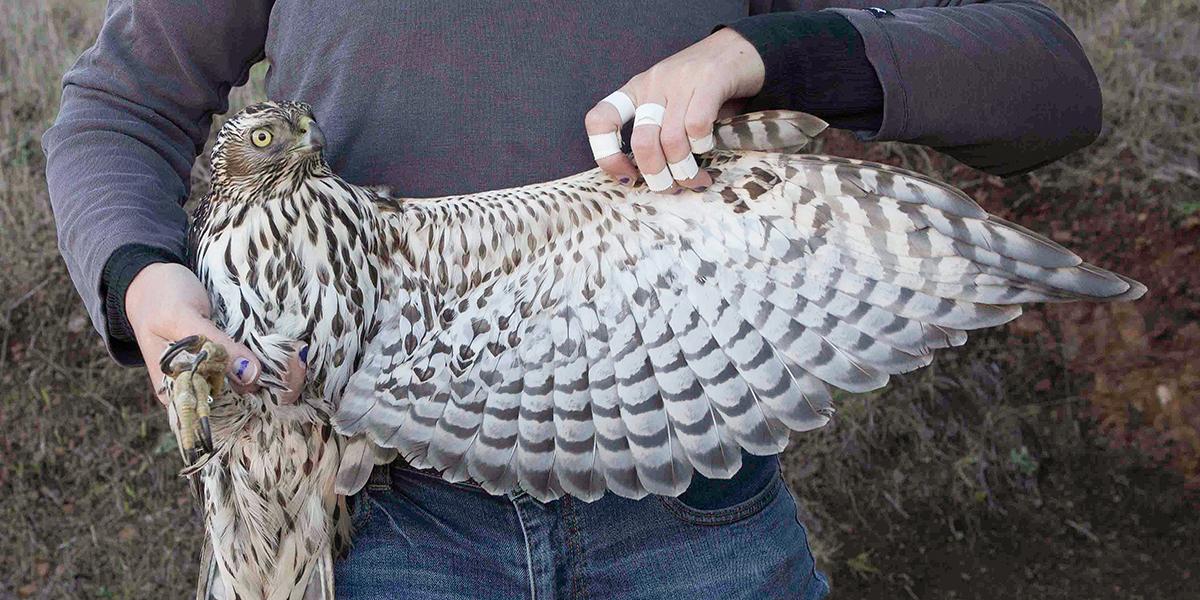Your parks need you now
Your support helps fight climate change and promote park sustainability—please give now.

This fall, the Golden Gate Raptor Observatory (GGRO) has the extraordinary honor of hosting the annual conference of the biggest raptor science group in the world—the Raptor Research Foundation—in Sacramento on November 4–8, 2015.
As part of the proceedings, the GGRO—a Parks Conservancy program in cooperation with the National Park Service—will help commemorate the 50th anniversary of a watershed moment in conservation science: the first gathering of biologists convened specifically to stop the disappearance of a species from the planet.
In 1965, Professor Joseph Hickey (Aldo Leopold’s successor at the University of Wisconsin-Madison) organized a meeting to address a disturbing phenomenon, which he described like this: “During the years 1950 to 1965, a population crash of nesting Peregrine Falcons occurred in parts of North America and Europe on a scale that makes it one of the most remarkable recent events in environmental biology.”
“Remarkable” is such a strange word here, but I think Hickey used it with intent to express both the tragedy of the event, and the awe with which we held our own human power. After all, we had nearly exterminated a species found across 40% of the earth’s surface and we didn’t know exactly how or why.
But didn’t we know why? Wasn’t this three years after the publication of Silent Spring, Rachel Carson’s Pulitzer Prize-winning argument for the elimination of DDT? That’s what I’d always thought—that the Hickey conference was the biologists’ follow-up act to Carson’s clarion call. But then why didn’t Carson’s name even appear in the proceedings?
I found one of the living and still-prominent members of the Madison Symposium, Dr. Tom Cade, last fall. Cade, the founder and executive director of the Peregrine Fund, explained it in just four words: “Carson was an activist.”
And that’s what set the stage for Madison. You see, in the mid-1960s you couldn’t be both the activist fighting for the cause and the scientist collecting data on the species. And Hickey knew that to keep the momentum going in the battle against pesticide overuse, the DDT-Peregrine connection needed a scientific shaking-out. So he invited over 60 eminent biologists from across the U.S., Canada, and Europe to Madison, Wis., for a four-day conference in late August 1965, and they shook hard.
The who’s-who list of experts considered every reason for the Peregrine’s decline (seen most precipitously in western Europe and the eastern U.S.): loss of prey, loss of habitat, changes in weather (before their time), and the new and sudden widespread use of agricultural chemicals.
Within three years of the Madison meeting, British biologists determined for certain that raptor eggshell-thinning was caused by DDT, proving Rachel Carson right: DDT attacks the reproductive success of birds of prey. Within 10 years, dozens of people were working for the recovery of the Peregrine Falcon across North America. Within 20 years, hundreds of people were working on Peregrines.
Then, within 35 years, the Peregrine was determined to be at such strong numbers across America, that this species—once the icon of endangerment—was declared “delisted,” no longer endangered.
The coordinated response that took place in the generation after Madison was nothing short of heroic. Never had a wild population of any species been so thoroughly analyzed and understood—and thus so quickly recovered. Was it biologists? Was it citizens? I think it was both.
That’s why I am walking through this ancient history with you. That Madison conference was the first time in history (that I can determine) that biologists came together to analyze the reasons for a disappearing species—while the species was still save-able.
It was, during that era, an unusual event where the “cold-hearted biologists” took a fierce, activist stance—we must stop the extinction of the Peregrine Falcon!—and they forged alliances; they initiated research and action plans; they behaved like citizens.
The moral of this old-timer’s tale has very contemporary resonances: Biologists and citizens need to work together more, sharing expertise and passion in equal measure. We need to focus on goals, educate the people and politicians, and save some species.
This is exactly what makes the GGRO an incredible place. We bring biologists and citizens together and keep a tight focus on the long-term monitoring of California’s birds of prey. In our own humble way, we are keeping alive the tradition that started in Madison 50 years ago— and making it the basis of a program in our nation’s most visited national park unit, the Golden Gate National Parks. I think that’s great.
And it’s our great honor to bring to Sacramento a gathering of eight of the original Madison Peregrine Symposium participants for a plenary talk on Saturday, November 7.
We will hold a panel to talk with these remarkable scientists about their memories of Hickey’s gathering, the road that lay ahead, and the importance of that gathering in the early days of conservation biology, a pivotal event that continues to inspire our work to this day.
Click here to make a contribution to support the GGRO in hosting this important scientific gathering.
For more information on the 2015 Raptor Research Foundation conference, please visit raptorresearchfoundation.org. The RRF2015 Conference has been made possible by the Greg Hind Endowment and contributions from passionate conservationists like you.
Your support helps fight climate change and promote park sustainability—please give now.